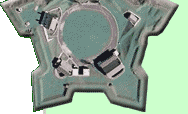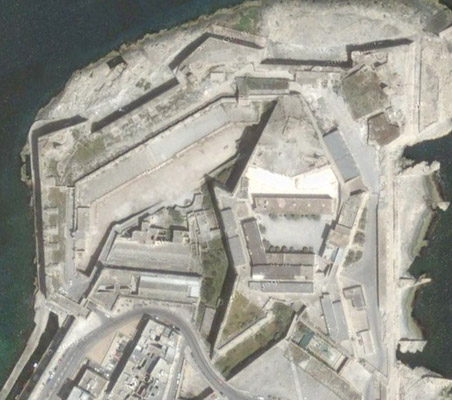
 |
 |
Fort Saint Elmo Valetta, Malta |
 |
 |
 |
 |
 |
||
 |
The Knights of Saint John, an organization that had its roots in the Knights Hospitaliers who cared for the sick and wounded in the Holy Land starting in the First Crusade (1099),
landed on Malta (just south of Sicily) in 1530 and immediately noted that a fluffy kitten in a tiny sailboat could easily capture the island's best port, it being completely undefended. The Knights started
the pile of rocks that would be Fort Saint Elmo in 1533. The Knights named Fort Saint Elmo after Erasmus of Formiae, a Christian saint and martyr who died circa 303AD. Eastern Roman Emperor Diocletian (244-311) disliked Erasmus' annoying preachin' ways, so had the Christian beaten and "besprinkled with foulness," then did various more inventive things to him, all of which were conveniently turned aside by angels. Western Roman Emperor Maximian (250-310) took a turn at Erasmus next, getting extremely inventive in his torture methods. Those angels alternately protected and/or healed Erasmus for a while, but finally got bored and allowed him to heroically perish...thank goodness, otherwise we'd never have a martyr! Erasmus became Saint Elmo, the patron saint of sailors. He was said to have kept preaching even after a near miss from a lightning bolt (which makes it seem to me that the guy wasn't any more popular with God than he was with Roman Emperors), which made sailors, always at risk from weather, claim him as their saint. Ottoman Turks, led by Sultan Suleiman the Magnificent (1494-1566), had ejected the Knights from thir previous island home of Rhodes in 1522. Holy Roman Emperor Charles V (1500-1558) gave the Knights Malta (technically he sold Malta to the Knights, for the cost of one falcon to be sent annually to the Viceroy of Sicily) so they could stop aimlessly floating around. Barbary corsairs, such as Turgut Reis (1485-1565), caused no end of trouble for the Knights and pretty much anyone else who wasn't a Muslim through the 1540s and 1550s - and the Knights certainly did their best to mess with the Ottomans. Turgut and his allies captured the entertainingly-named island of Gozo, just to the north of Malta, in 1551. They followed this success by seizing the Knights' stronghold in Tripoli. Anyone could see that Malta was next on the Turkish agenda, so the Knights finished Fort Saint Elmo and built Fort Saint Michael in a six-month period of 1552. When the Ottoman invasion came in 1565, Fort Saint Elmo held out for over a month against a constant bombardment from Turkish cannon on Mount Sciberras (you'd think the guys who sited these forts would notice nearby high ground) , but finally fell on June 23 1565. All but nine of the fort's defenders were slain. Turgut Reis was killed during the battle by shrapnel from the Knights' cannon fire. Obviously considering their victory to be all-encompassing, the Turks cleared out of Malta after the siege. Grandmaster of the Order of Saint John, Jean Parisot de la Valette (1494-1568) laid the first stone of what would become Valetta on March 28 1566, and Fort Saint Elmo was rebuilt atop the rubble of its original incarnation. The Knights in Malta continued their mission of fortifying their stronghold and caring for the infirm somewhat unmolested for the next 232 years, until the arrival of...guess who? Clues: He was short and there's a complex named after him. Right! Napoleon (1769-1821) and his navy, on their way to Egypt in 1798, parked at Valetta and asked for permission to resupply their ships. When the Knights granted that permission in their courtly manner, the French took over and the Knights of Malta were ejected from Malta, making them once again the Knights of Nowhere In Particular. The Knights of Saint John eventually made their way to Rome, where today they exist as a sovereign non-nation, complete with their own military arm (which exists as an auxiliary force to the Italian Army), license plates and, for a period after the Second World War (1939-1945), their own air force! Meanwhile, back in the early 19th century, the French proved an unpopular ruling body with the Maltese, due perhaps to their disdain for Catholicism (and policy of looting everything). The French were eventually forced to take shelter in the many fortifications in and around Valetta when the Maltese rebelled, aided by the British, who were always happy to cause trouble for Napoleon. Upon the Treaty of Versailles in 1814, the Maltese people whipped up a Declaration of Rights and agreed to be governed by Britain. German and Italian air raids severely damaged Valetta during the Second World War. Britain's King George VI (1895-1952) awarded the Maltese people with a George Cross, Britain's highest civilian award, in 1942. The medal is now on display in Valetta's National War Museum, which is located in Fort Saint Elmo. After the war, Fort Saint Elmo became the home for Malta's Police Academy. Today the fort is a popular tourist attraction, and was used as the setting for a Turkish prison in the 1978 film Midnight Express. |
 |
 |
||
|
|
|||||||
Info Source 1
Info Source 2
Info Source 3
Info Souce 4
Info Source 5 Info Source 6 Info Source 7 Info Source 8 Info Source 9 Info Source 10 Info Source 11 Info Source 12 Info Source 13 Info Source 14 Thanks to Google Maps for the image! ©2010 starforts.com |
 |